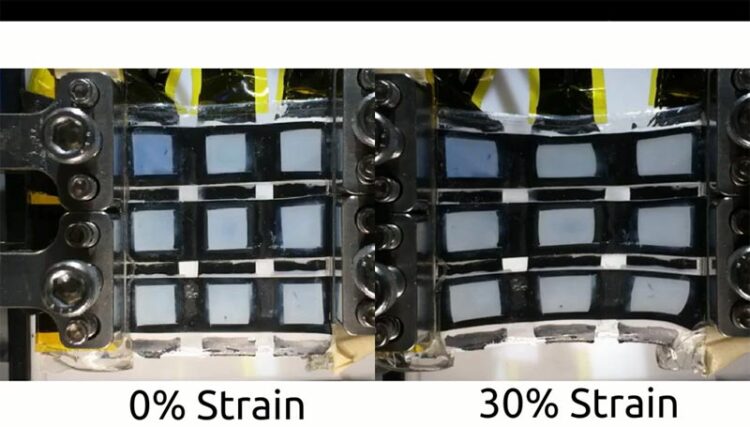Stretchy color-changing display points to future of wearable screens

Stretchy colour-changing display. Credit: University of British Columbia
Imagine a wearable patch that tracks your vital signs through changes in the colour display, or shipping labels that light up to indicate changes in temperature or sterility of food items.
These are among the potential uses for a new flexible display created by UBC researchers and announced recently in ACS Applied Materials and Interfaces.
“This device is capable of fast, realtime and reversible colour change,” says researcher Claire Preston, who developed the device as part of her master’s in electrical and computer engineering at UBC. “It can stretch up to 30 per cent without losing performance. It uses a colour-changing technology that can be used for visual monitoring. And it is relatively cheap to manufacture.”
Previous attempts at creating stretchable displays have involved complex designs and materials, limiting their stretchability and optical quality. In this new research, scientists leaned on electrochromic displays—which are able to reversibly change colour, while requiring low power consumption—to overcome these limitations.
“We used PEDOT:PSS, an electrochromic material that consists of a conductive polymer combined with an ionic liquid, resulting in a stretchable electrode that acts as both the electrochromic element and the ion storage layer. This simplifies the device’s architecture and eliminates the need for a separate stretchable conductor,” says Ms. Preston.
The display is transparent and feels like a stiff rubber band. To support the thin layers of PEDOT and allow them to elongate without breaking, the team added a solid polymer electrolyte and a stretchable encapsulation material called styrene-ethylene-butylene-styrene (SEBS).
“The potential uses for this stretchable display are significant. It could be integrated into wearable devices for biometric monitoring, allowing for real-time visual feedback on vital signs. The displays could also be used in robotic skin, enabling robots to display information and interact more intuitively with humans,” noted senior author Dr. John Madden, a professor of electrical and computer engineering who supervised the work.
Additionally, the low power consumption and cost-effectiveness of this technology make it attractive for use in disposable applications such as indicator patches for medical purposes or smart packaging labels for sensitive shipments. It could also be used to actively change the colour of jackets, hats and other garments.
“While there is need for more work to integrate this device into everyday devices, this breakthrough brings us one step closer to a future where flexible and stretchable displays are a common part of our daily lives,” Dr. Madden added.
Interview language(s): English (Madden)
Journal: ACS Applied Materials & Interfaces
DOI: 10.1021/acsami.3c02902
Method of Research: Experimental study
Subject of Research: Not applicable
Article Title: Intrinsically Stretchable Integrated Passive Matrix Electrochromic Display Using PEDOT:PSS Ionic Liquid Composite
Article Publication Date: 5-Jun-2023
Media Contact
Lou Corpuz-Bosshart
University of British Columbia
lou.bosshart@ubc.ca
Office: 604-999-0473
Video: Colour-changing display
All latest news from the category: Materials Sciences
Materials management deals with the research, development, manufacturing and processing of raw and industrial materials. Key aspects here are biological and medical issues, which play an increasingly important role in this field.
innovations-report offers in-depth articles related to the development and application of materials and the structure and properties of new materials.
Newest articles

Innovative 3D printed scaffolds offer new hope for bone healing
Researchers at the Institute for Bioengineering of Catalonia have developed novel 3D printed PLA-CaP scaffolds that promote blood vessel formation, ensuring better healing and regeneration of bone tissue. Bone is…

The surprising role of gut infection in Alzheimer’s disease
ASU- and Banner Alzheimer’s Institute-led study implicates link between a common virus and the disease, which travels from the gut to the brain and may be a target for antiviral…

Molecular gardening: New enzymes discovered for protein modification pruning
How deubiquitinases USP53 and USP54 cleave long polyubiquitin chains and how the former is linked to liver disease in children. Deubiquitinases (DUBs) are enzymes used by cells to trim protein…



